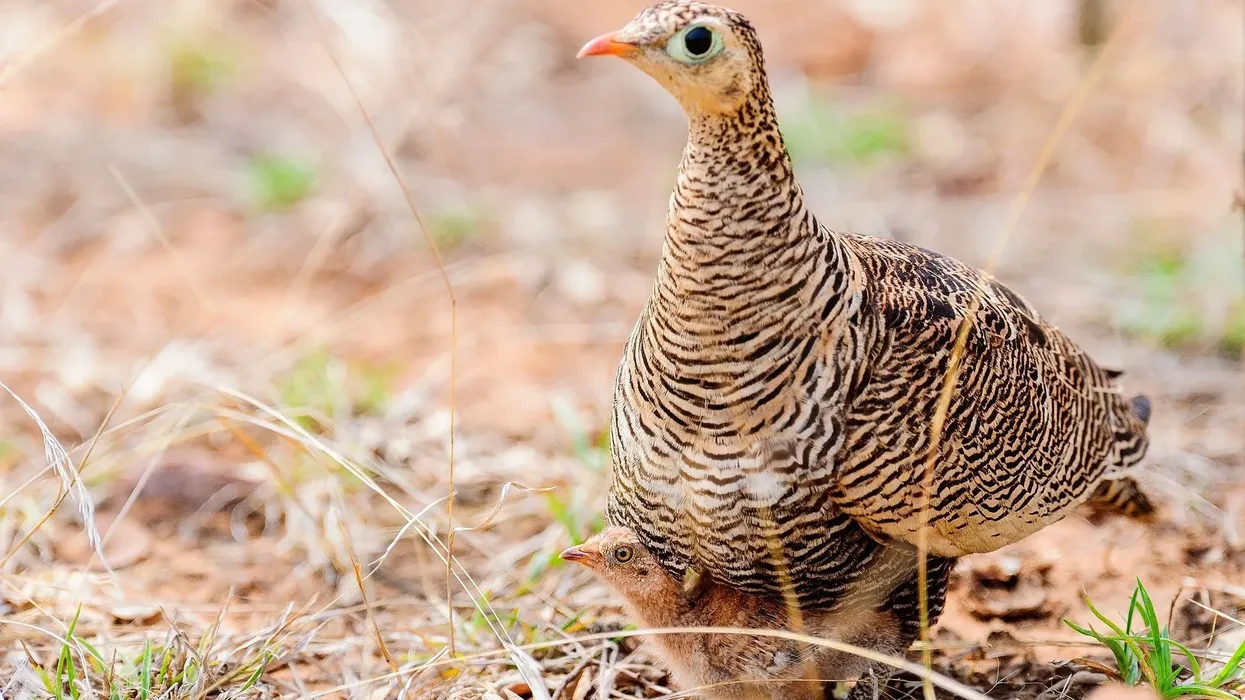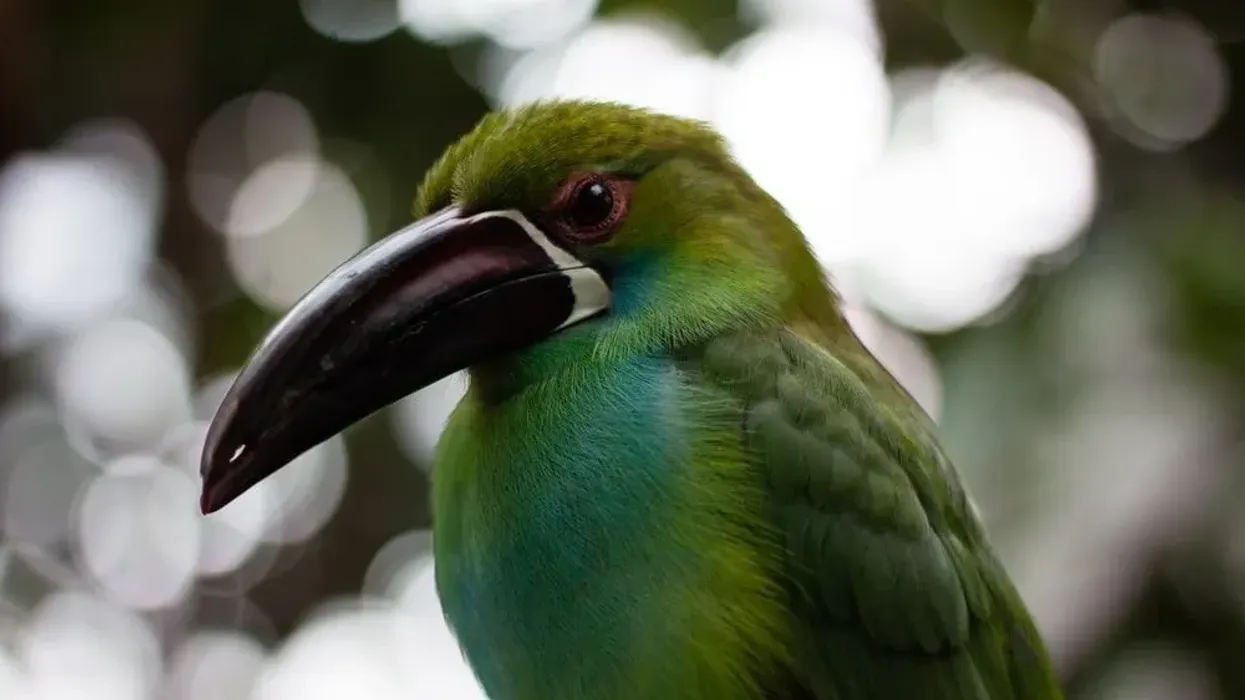The painted sandgrouse (Pterocles indicus) is a resident bird found in central and northwestern India. It is a pair-bonding terrestrial bird. It grows in low-rainfall locations on sandy and gravelly plains with tussocky grass and harsh plants.
Bhat teeter is the local name for painted sandgrouse (Pterocles indicus). The painted sandgrouse is a large ground bird with a tiny head and short legs.
It is sociable, and groups assemble to drink at waterholes. The painted sandgrouse is around 9-16 in (22.8-40.6 cm) long, including the tail. Adults weigh between 0.4-0.5 lb (181.4-226.7 g).
The painted sandgrouse is one of the most beautiful of its kind. It has a brighter coloring than the chestnut-bellied sandgrouse, which has a duller hue.
A large black and white ribbon wraps across the chest. Its eye-catching black and white patterns aid in its search for 'the one.' During its mating ritual, the adult male painted sandgrouse displays its beautiful plumage to the adult female.
Read on for more! Also, take a look at our pileated woodpecker facts and ivory-billed woodpecker facts.
Painted Sandgrouse Interesting Facts
What type of animal is a painted sandgrouse?
The painted sandgrouse (Pterocles indicus, Gmelin, 1789) is a bird of order Pterocliformes and family Pteroclidae.
What class of animal does a painted sandgrouse belong to?
The painted sandgrouse (Pterocles indicus) belongs to the class Aves, order Pterocliformes and family Pteroclidae.
How many painted sandgrouses are there in the world?
The species' adult worldwide population number has not been measured, although it is characterized as relatively abundant in areas of India and uncommon in Pakistan. In the absence of evidence of reductions or significant threats, the adult population is said to remain stable.
Where does a painted sandgrouse live?
The painted sandgrouse (Pterocles indicus) lives in arid habitats such as rough grassland, rocky terrain, and scrub and feeds mostly on seeds. It is sociable, and groups assemble to drink at waterholes. The painted sandgrouse is a resident bird found in central and northwestern India, Pakistan, and Afghanistan.
What is a painted sandgrouse's habitat?
The painted sandgrouse (Pterocles indicus) species is found in dry and rocky areas such as rough grassland habitat, rocky terrain regions, and scrub habitat. It is sociable, with groups congregating to drink in waterholes. It is well hidden in the landscape and cannot be seen unless a person goes through it.
Enjoys stark stone plateaus, arid scrub, and open woods. It is a pair-bonding terrestrial bird. It grows in low-rainfall locations on sandy and gravelly plains with tussocky grass and harsh plants.
Who do painted sandgrouses live with?
Although gregarious, the common Indian sandgrouse genus is typically observed in flocks of 5-40 or more birds. Unusual circumstances, such as a lack of drinking holes, can drive a hundred or even thousands of birds to gather in huge flocks.
How long does a painted sandgrouse live?
There is no information available about wild birds. In Nevada, wild-caught birds have lived in a captive habitat for three years. The male and female ratio appears to be balanced. Their generation length, the average time between when children are born, when they become adults, and when they start having children, is six years.
How do they reproduce?
Sandgrouse, like pigeons, mate for life. Breeding occurs at any time of year and is weather-dependent. Normally, the nests are solitary, although numerous pairs of birds will pick locations close to each other.
Over the course of a few days, the adult female produces two or three pinkish-gray eggs with brown markings. The adult male incubates them at night. The chicks can leave the nest nearly immediately after hatching, although they are well cared about by their parents.
What is their conservation status?
This species of family Pteroclidae has a very broad range, the population trend appears to be steady, and the adult male and female population number has not been measured, but it is not thought to approach the Vulnerable criteria using the population size criterion. As a result, the species is classified as Least Concern.
Painted Sandgrouse Fun Facts
What do painted sandgrouse look like?
The painted sandgrouse (Pterocles indicus) is a chubby ground-dwelling bird with a tiny head and short legs. The male and female have distinct colors.
The bill of the male is orange, with a black bar across the white forehead, faint black longitudinal lines on the neck, and a white patch of exposed skin surrounding the eye. A wide black and white ribbon wraps across the chest of the male.
The breast and belly are a consistent pinkish-brown color, while the back, wings, and tail are brown with black and white transverse bands. The female is duller in appearance, having a grayish-brown colored coat that is barred and speckled with darker brown/ black and white.

How cute are they?
The thing regarding the 'sand' is accurate cause they're brown. But what about the 'grouse'? Not at all. The sandgrouse, which belongs to the Pteroclididae family, is related to pigeons and doves.
They're a lovely bunch, especially if you prefer earthy brown tones. Isn't their concealment admirable? They appear to be around the same size as their pigeon counterparts. One of the most attractive species is the painted sandgrouse. It is brighter in color than the chestnut-bellied sandgrouse, which is duller brown colored.
How do they communicate?
The common sandgrouse will continually emit a 'cluck-cluck' while flying, which can be heard from a long distance and is useful in locating the birds.
How big is a painted sandgrouse?
The painted sandgrouse (Pterocles indicus) is around 9-16 in (22.8-40.6 cm) long, including the tail. The painted sandgrouse is a large ground bird with a tiny head and short legs.
How fast can a painted sandgrouse fly?
They have 11 strong main feathers and long pointed wings, allowing them to fly quickly and directly. The muscles in the wings are strong, and the birds can take off quickly and fly for long periods of time.
The center feathers of the tail of certain species are expanded into long points. They communicate with one another while flying and can achieve speeds of up to 45 mph (72.4 kph).
How much does a painted sandgrouse weigh?
The weight of the several sandgrouse species ranges from 0.4-0.5 lb (181.4-226.7 g). The painted sandgrouse weighs between 0.3-0.5 lb (170-230 g).
What are the male and female names of the species?
The male and female of the species do not have distinct names they are simply called male and female painted sandgrouse
What would you call a baby painted sandgrouse?
A chick is a name given to this bird's young whether it is male or female.
What do they eat?
Their primary source of food is seeds, although they also consume leaves, stems, grains, flowers, small fruit, insects, and mollusks. They might also prey on ants and termites.
Are they dangerous?
The sandgrouse has minimal interaction with humans, owing to the fact that the majority of species dwell in dry, unpopulated environments at low densities. They are not commonly sought after as game birds since they are not particularly tasty, but they have been captured in large numbers near water holes on occasion.
Would they make a good pet?
These birds are not appropriate to have as pets as they are wild animals.
Did you know...
Their coloring reflects adaptability to their environment, which is typically dry, dusty, and desolate. They are found in pairs, as opposed to other sandgrouses, which are known for congregating in large numbers around waterbodies at certain times of the day to drink water. Even in intense heat, most sandgrouses only drink once a day.
How does a sandgrouse carry water?
Feathers are a characteristic that only birds have. They protect the skin, offer warmth and insulation, aid in flight, gender recognition, and mate attraction.
However, in the case of some birds, feathers aid with another very particular talent. Modified belly feathers assist certain birds in transporting water for distances of up to 62.1 mi (100 km)!
The sandgrouse, which dwells in arid to semi-arid regions and breed in the summer, carry water in their belly feathers to chill their eggs or supply water to their parched young.
Is the painted sandgrouse a ground-dwelling bird?
The painted sandgrouse is a large ground bird with a tiny head and short legs. They are only found in open, treeless areas such as grasslands, savannahs, and semi-deserts.
They are found in northern, southern, and eastern Africa, Madagascar, the Middle East, and India, as well as central Asia. The sandgrouse is among the most terrestrial birds, eating, roosting, and breeding on the ground. They fly to water nearly every day, traveling up to 75 mi (120.7 km) round-trip, depending on the proximity of feeding sites.
Here at Kidadl, we have carefully created lots of interesting family-friendly animal facts for everyone to discover! For more relatable content, check out these western kingbird facts and myna bird facts for kids.
You can even occupy yourself at home by coloring in one of our free printable painted sandgrouse coloring pages.
Second image by Rudraksha Chodankar.










